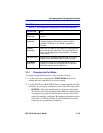
Chapter 3: VLAN Configuration
3-16 802.1Q VLAN User’s Guide
• 1Q TRUNK – This mode sets the port for transmitting to another
802.1Q aware device. In this mode, all frames are transmitted with
a tag header included in the frame (excluding BPDUs). The switch
will drop all untagged frames it receives on the 1Q Trunk port. The
Port VLAN List for the port includes all VLANs.
• 1D TRUNK – This mode sets the port for transmitting to a legacy
802.1D switch fabric. In this mode, all incoming frames are
classified into the default VLAN and all frames are transmitted
untagged. The switch expects to receive only untagged frames
through the 1D Trunk port. This mode also updates the Port
VLAN List and makes the port eligible to transmit frames for all
VLANs. The 1D Trunk mode can be used in conjunction with the
“Forward Default VLAN Out All Ports” parameter and the Default
VLAN to allow all stations on a legacy portion of the network to
access all stations or servers in the 802.1Q portion of the network.
3. When the desired operational mode for the port is displayed, use the
arrow keys to highlight the SAVE command at the bottom of the
screen.
4. Press ENTER. The message “SAVED OK” displays.
3.5.2 Assigning a VLAN ID
The Port Assignment Configuration screen also enables the user to set
each port’s VLAN ID (PVID) by stepping through a list of all configured
VLANs. To assign a VLAN ID to a port in this manner, perform the
following steps:
1. Use the arrow keys to highlight the VLAN ID field for the port
combination you wish to change.
2. Use the SPACE bar or BACKSPACE key to step sequentially through
the previously configured VLAN ID numbers. Only existing VLAN
IDs will be displayed.
NOTE
It may be necessary to use the NEXT and PREVIOUS
commands to page through the available ports. For
instructions, refer to Section 3.5.3.


















